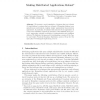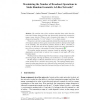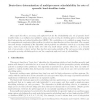OPODIS
2004
15 years 2 months ago
2004
Consider an asynchronous system where each process begins with an arbitrary real value. Given some fixed > 0, an approximate agreement algorithm must have all non-faulty process...
74
Voted
OPODIS
2004
15 years 2 months ago
2004
A network is k-connected if it remains connected after the removal of any k - 1 of its nodes. Assume that n sensors, modeled here as (omni)directional antennas, are dropped random...
OPODIS
2007
15 years 2 months ago
2007
Network overlays have been the subject of intensive research in recent years. The paper presents an overlay structure, S-Fireflies, that is self-stabilizing and is robust against ...
106
Voted
OPODIS
2007
15 years 2 months ago
2007
Abstract. We consider the problem of synchronizing clocks in synchronous systems prone to transient and dynamic process failures, i.e., we consider systems where all processes may ...
111
Voted
OPODIS
2007
15 years 2 months ago
2007
This paper presents Timed Quorum System (TQS), a quorum system for large-scale and dynamic systems. TQS provides guarantees that two quorums, accessed at instances of time that are...
107
click to vote
OPODIS
2007
15 years 2 months ago
2007
We present a novel translation of systems that are tolerant of crash failures to systems that are tolerant of Byzantine failures in an asynchronous environment, making weaker assum...
OPODIS
2007
15 years 2 months ago
2007
111
Voted
OPODIS
2007
15 years 2 months ago
2007
Peer to peer overlay networks have proven to be a good support for storing and retrieving data in a fully decentralized way. A sound approach is to structure them in such a way tha...
103
Voted
OPODIS
2007
15 years 2 months ago
2007
In Sensor Networks, the lack of topology information and the availability of only one communication channel has led research work to the use of randomization to deal with collisio...
129
Voted
OPODIS
2007
15 years 2 months ago
2007
This report describes a necessary and sufficient test for the schedulability of a set of sporadic harddeadline tasks on a multiprocessor platform, using any of a variety of schedu...



